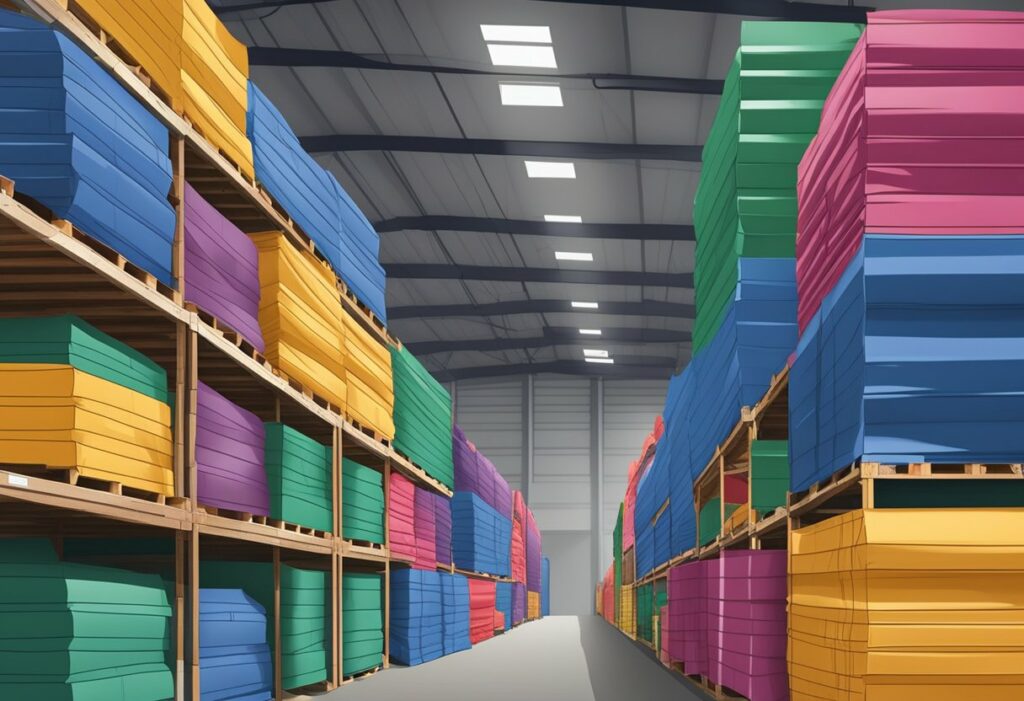Tarps, or tarpaulins, are versatile and durable sheets made of various materials that serve a range of purposes, from protecting items against the elements to providing temporary shelter. One aspect of tarps that might not immediately come to mind is the color. Surprisingly, the color of a tarp can have an impact on its usage and functionality. In this article, we will explore the significance of tarp colors and how they can be beneficial for various applications.
Different tarp colors cater to specific purposes that may correlate with function or aesthetics. While the color of a tarp may initially seem like a personal preference, these colors can also provide advantages relating to visibility, temperature regulation, and the level of light penetration. By understanding the properties and benefits associated with specific tarp colors, users can select the most suitable tarp for their particular needs.
Key Takeaways
- Tarp colors serve both functional and aesthetic purposes, with each color offering unique benefits.
- Factors such as visibility, light penetration, and temperature regulation play a role in determining the most appropriate tarp color for a given application.
- Consumers should evaluate their needs and consider the advantages of each tarp color when choosing the right product for their requirements.
Understanding Tarp Materials
Polyethylene Tarps
Polyethylene tarps are among the most popular and versatile materials available. They are lightweight and affordable, making them suitable for various applications. These tarps are typically water-resistant, rot-resistant, and UV-protected. Polyethylene tarps come in a range of colors and thicknesses and are often referred to as “blue tarps” because of their most common color.
Vinyl Tarps
Vinyl tarps are known for their durability and strength, making them ideal for heavy-duty applications. Made from PVC, these tarps are resistant to chemicals, abrasion, and tearing. Vinyl tarps are available in various weights, thicknesses, and colors. They are commonly used for situations requiring a high level of water resistance and can be found in materials like clear PVC tarps and truck tarps.
Canvas Tarps
Canvas tarps are made from either cotton canvas or a blend of polyester and cotton materials. These tarps are known for their breathability and durability, making them ideal for protecting equipment or outdoor furniture from moisture and sunlight. Canvas tarps come in various weights and colors and can be treated for additional features, such as flame retardance and water resistance. Canvas tarps are preferred in situations where condensation buildup is a concern.
Mesh Tarps
Mesh tarps consist of woven fabrics, typically made from polyester or nylon and coated with PVC. These tarps provide partial protection against elements while allowing air circulation, making them suitable for shade, privacy, and windbreak applications. Mesh tarps are commonly used in areas like patios, gardens, and nurseries. They are available in various colors, densities, and sizes.
Specialty Materials
In addition to the standard tarp materials, there are specialty materials designed to cater to specific needs. Examples of these materials include:
- Iron Horse Polyester Tarps: A blend of polyester and vinyl, these tarps offer the benefits of both vinyl and canvas materials, including durability, low stretch, and resistance to water and UV rays.
- Rip-Stop Tarps: These tarps are made of sturdy fabrics featuring a reinforced grid for enhanced strength and tear resistance.
- Insulated Tarps: Insulated tarps consist of multiple layers, providing extra insulation and protection in colder environments or for temperature-sensitive equipment.
When selecting a tarp, consider the material’s properties and the intended application to ensure you choose the right tarp for your needs.

Tarp Colors and Their Purposes
Blue Tarps
Blue tarps are the most common and versatile type of tarp, offering protection from rain, debris, and dust. They provide mild weather resistance and are suitable for general-purpose use, such as covering equipment or providing a temporary shelter. Blue tarps are typically made of lightweight, water-resistant material, making them affordable and accessible for a broad range of uses.
White Tarps
White tarps are often chosen when a clean appearance or high visibility is required. They reflect sunlight, keeping the area underneath cooler and providing better shade than darker-colored tarps. This makes them ideal for outdoor events such as picnics and fairs where comfort and aesthetics are important. Additionally, white tarps are commonly used in construction projects where high visibility is beneficial for safety.
Green Tarps
Green tarps are a great option for blending into natural surroundings or providing shade in outdoor settings. They are often used for camping, hunting, or landscaping projects due to their ability to blend in with the environment. Like white tarps, green tarps are effective at reflecting sunlight, helping to keep the area beneath them cooler.
Red Tarps
Red tarps are designed for high-visibility situations, making them the preferred choice for construction, industrial, and agricultural applications. Their bright color is easily noticeable, which can help to mark important equipment or flag down help in case of an emergency.
Yellow Tarps
Yellow tarps, similar to red tarps, are utilized in situations where visibility is crucial. Their vibrant color makes them easily noticeable, ensuring that they can be seen in various lighting conditions. Yellow tarps are often used for storage, transportation, and safety purposes.
Silver Tarps
Silver tarps provide exceptional UV protection and are more robust than standard blue tarps. Their reflective properties help to keep the area underneath cool, making them an excellent choice for sun protection. Silver tarps are commonly found in applications where prolonged exposure to the elements is expected, such as covering boats, RVs, or equipment stored outdoors.
Black Tarps
Black tarps are ideal for situations where privacy is needed, or when absorption of sunlight is desired. These tarps can block out light effectively, making them suitable for use as a theater or photography backdrop, or for covering materials that need to stay dark. Black tarps are also often used in landscaping for weed control purposes.
Clear Tarps
Clear tarps serve as an excellent option for situations where protection from the elements is necessary, yet visibility and light transmission are essential. They are often seen covering outdoor spaces such as porches, greenhouses, or retail displays. Clear tarps provide the advantage of protecting the items beneath while still allowing natural light to pass through.
Properties of Tarps
Waterproof and Weather-resistance
Tarps are designed to be durable and protective against harsh weather conditions. They are commonly made from materials such as polyethylene and vinyl, which offer excellent waterproof and moisture resistance. These tarps can effectively protect various equipment, supplies, and structures from rain and other elements. They also exhibit strength, ensuring that they can withstand extended exposure to outdoor conditions.
UV Protection
Protecting your belongings from the sun’s harmful UV rays is crucial. Many tarps come with UV protection, which helps shield the items they are covering from sun damage and fading. Additionally, UV-protected tarps tend to last longer, as they are less likely to degrade under sunlight, further enhancing their durability.
Mildew and Rot Resistance
Mildew and rot resistance are essential properties in tarps, especially if they will be exposed to moisture for extended periods. Many tarps, particularly those made from synthetic materials like polyethylene, have inherent resistance to mildew and rot. This feature not only helps keep the tarp in good condition but also protects the items stored beneath it from mold and mildew growth.
Tear and Abrasion Resistance
Tarps must be strong and capable of withstanding tears and abrasions. The use of heavy-duty materials, such as vinyl, and reinforcement layers contributes to a tarp’s overall strength. Many tarps feature rip-stop fabrics or weave patterns that prevent tears from spreading. This tear and abrasion resistance property is especially important for construction, industrial, and agricultural purposes, where tarps are subjected to rough conditions.
Fire Retardancy
In some situations, it may be essential to have a fire-retardant tarp. Fire retardant tarps are treated with special chemicals that reduce the likelihood of catching fire. These tarps can be crucial for applications where the risk of fire is present, such as camping, temporary shelters, or industrial settings. Note that fire retardant tarps may not be entirely fireproof, but they provide added protection by delaying and resisting ignition.
Design Features of Tarps
Grommets and Tie-Downs
Grommets are an essential feature of tarps, providing secure attachment points for ropes, bungee cords, or other tie-downs. They are typically made of metal or heavy-duty plastic to ensure durability and strength. Tarps often have grommets spaced evenly around their edges, allowing for versatile and secure coverage of various items or areas.
Heavy-duty tarps may have reinforced corner grommets, which provide extra protection against wear and tear, making them ideal for use in high-stress situations such as construction sites or for covering large objects like trucks.
Reinforced Edges
To increase the strength and durability of tarps, many designs include reinforced edges. This reinforcement typically consists of an additional layer of material, such as heavy-duty polyethylene or vinyl, which is folded over the tarp’s edge and secured in place using strong stitching. Reinforced edges prevent fraying and extend the lifespan of the tarp, making them an essential feature for heavy-duty and long-term use.
Seams and Stitching
The quality of seams and stitching plays a crucial role in the overall durability and performance of a tarp. High-quality tarps should feature double-stitched seams, which provide added resilience against wear and tear. This is particularly important for heavy-duty tarps used in demanding environments such as construction sites or outdoor storage areas.
Some tarps may also have heat-sealed or welded seams, providing an even stronger bond between the material layers. These seams create a water-tight, fully weather-resistant barrier, which helps to protect stored items and structures from the elements.

Tarp Sizes and Customization Options
Standard Sizes
Tarps come in a variety of standard sizes to suit different purposes. Some common sizes include:
- 6’x8′
- 8’x10′
- 10’x12′
- 12’x16′
- 16’x20′
These sizes can accommodate a wide range of uses, from covering small outdoor furniture to large construction sites. It’s essential to choose the appropriate size for your needs, keeping in mind that a larger tarp can offer better coverage and versatility.
Super heavy-duty tarps are designed for more demanding applications, such as long-term outdoor use, protecting heavy machinery, or withstanding harsh weather conditions. They’re typically made from higher-quality materials and come in various sizes as well.
Custom Sizing
For situations where standard tarp sizes don’t adequately suit your needs, many suppliers offer custom tarps. Custom sizing lets you tailor your tarp’s dimensions precisely, ensuring optimal coverage and protection for your specific application.
When ordering a custom tarp, be prepared to provide the exact dimensions you require and choose from a range of materials, colors, and features. Some popular options include:
- Custom canvas tarps
- Vinyl tarps
- Mesh tarps
In addition to custom size tarps, you can also request special features, such as additional grommets, reinforced corners, or customized tie-down options. These extra options can enhance the functionality and durability of your custom tarp.
Remember, having the right tarp size and customization options is essential for effective protection and optimal performance. Whether you opt for a standard size or a custom solution, ensure that your tarp meets your specific requirements.
Frequently Asked Questions
What significance do different tarp colors have in terms of use?
Different tarp colors often indicate their ideal use and durability. For instance, blue tarps are common due to the availability and inexpensiveness of the material, making them a popular choice for general-purpose applications. Brightly colored tarps, such as orange, red, and yellow, are best for situations where visibility is a high priority. Clear tarps allow for the passage of light while still providing protection from natural elements.
Which tarp color provides the most effective sun protection?
Mesh tarps, made from polyester or nylon, provide excellent sun protection. These tarps block harsh sunlight while allowing for breathability, making them ideal for creating shade in outdoor spaces and protecting plants from intense heat.
How does tarp color impact its durability and longevity?
Tarp color can be an indicator of the material’s durability and intended use. High-quality tarps may be available in various colors depending on their specific usage. Generally, the color itself does not impact the longevity of the tarp, but it’s essential to choose a tarp designed for your particular application.
What are the benefits of using a reflective tarp?
Reflective tarps have a silver or reflective coating, which makes them highly effective at redirecting sunlight and reducing heat absorption. These tarps are particularly useful for applications that require temperature control, such as covering outdoor equipment or providing shade for people and animals.
In terms of temperature regulation, which tarp color remains the coolest?
Light-colored tarps, especially those with a reflective coating, remain the coolest under the sun. The reflective surface helps repel sunlight, reducing heat absorption and maintaining a cooler temperature beneath the tarp.
Can decorative tarps also be functional in terms of weather resistance?
Yes, decorative tarps can be both aesthetically pleasing and functional in terms of weather resistance. It’s essential to select a high-quality tarp designed for outdoor use, considering factors such as UV resistance, waterproofing, and material strength. This way, you can ensure that your decorative tarp not only looks great but also provides the necessary protection against the elements.

